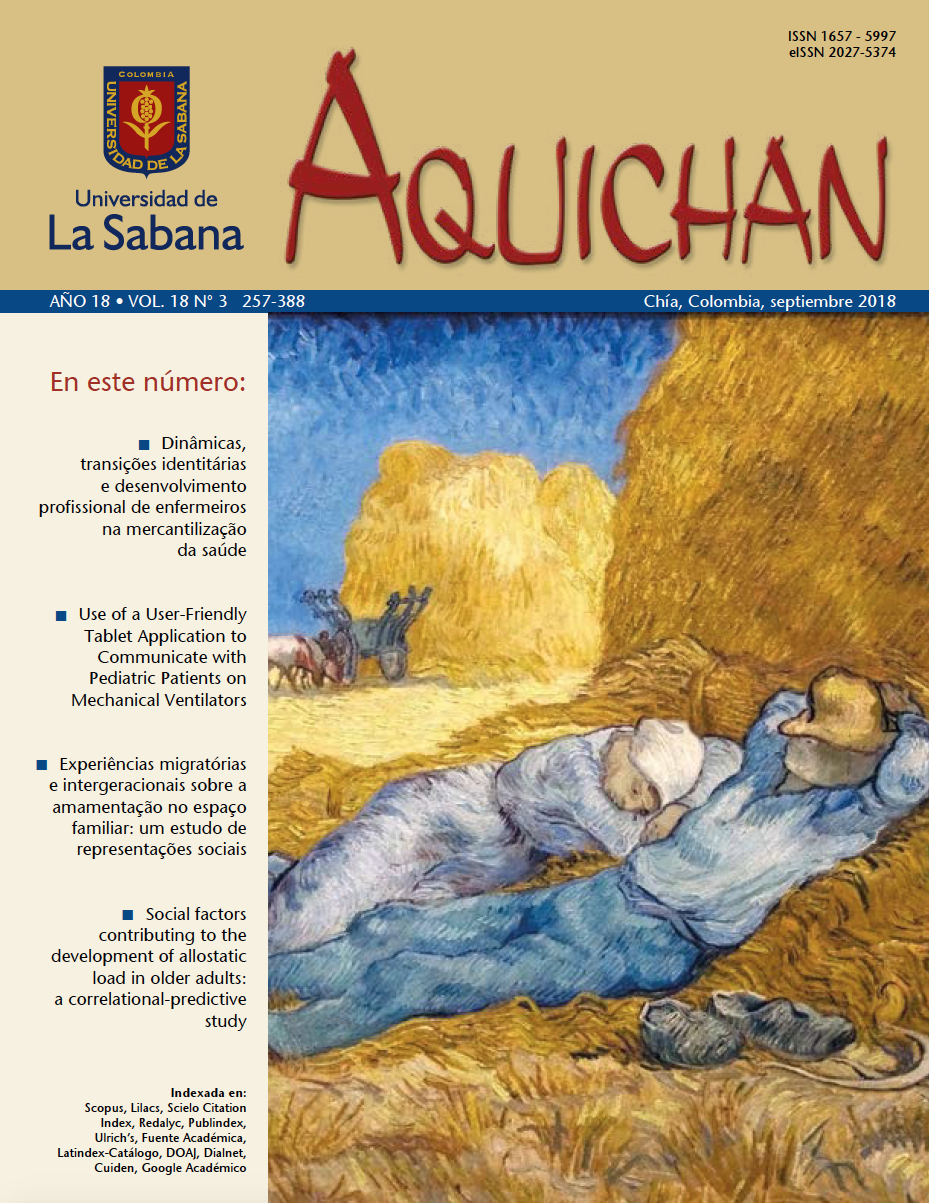Preditores da advocacia em saúde identificados por enfermeiros no contexto hospitalar
Keywords:
Advocacia em saúde, enfermagem, ética em enfermagem, defesa do paciente, hospitaisAbstract
Legal Predictors in Health Identified by Nurses in the Hospital Environment
Predictores de abogacía en salud identificados por enfermeros en el contexto hospitalario
Objectives: The purpose of this study was to identify the predictors of the practice of health advocacy by nurses in the hospital environment. Materials and methods: This is a quantitative, cross-sectional analytical study carried out with 157 nurses from two hospitals in southern Brazil, one public and one philanthropic. Data collection was done between September and October 2015. The Brazilian version of the Protective Nursing Advocacy Scale, consisting of 20 items, arranged in five constructs, was the instrument was used. Elements of descriptive statistics, the Pearson correlation and linear regression analysis were used to examine the data. Results: The study showed a moderate association between facilitators of the practice of advocacy and perceptions that favor its exercise. The dimension "facilitators of the practice of advocacy" obtained the highest average with the instrument and was the main legal predictor in health in the hospital context, capable of inspiring in nurses the sensitivity and desire to advocate. Conclusions: The nurse has a feeling of responsibility to make sure equipment continues to function properly and to handle conflicting questions when offering security to patients, even in the face of resistance originating in the workplace.Downloads
References
Hamric AB, Borchers CT, Epstein EG. Development and testing of an instrument to measuremoral distressin healthcare professionals. Am. j. bioeth. 2012; 3(2):1-9.
Hanks RG. The medical-surgical nurse perspective of advocate role. Nurs. forum. 2010; 45(2):97-107. 107. doi: 10.1111/j.1744-6198.2010.00170.x
Vaartio H, Leino-Kilpi H, Suominen T, Puukka P. Nursing advocacy in procedural pain care. Nurs. ethics. 2009; 16(3):340-62.
Annas GJ. The patient rights advocate: can nurses effectively fill the role? Superv. nurse. 1974; 5(7):20-5.
Selanders L, Crane P. The Voice of Florence Nightingale on Advocacy.Online J. Issues Nurs. 2012; 17(1). doi: 10.3912/ OJIN.Vol17No01Man01
Andrade RD, Mello DF. Organizações sociais e instituições governamentais: perspectivas de parceria na atenção à saúde da criança através dos voluntários e da pastoral da criança. Rev Esc Enferm. USP. 2006; 40(1):93-7.
Barlem ELD, Lunardi VL, Lunardi GL, Tomaschewski-Barlem JG, Silveira RS. Moral distress in everyday nursing: hidden traces of power and resistance. Rev Latinoam. enferm. 2013; 21(1):293-9.
Hanks RG. Development and testing of an instrument to measure protective nursing advocacy. Nurs. ethics. 2010; 17(2):255-67.
Arries EJ. Patient safety and quality in healthcare: Nursing ethics for ethics quality. Nurs. ethics. 2014; 21(1):3-5.
Vaartio H, Leino-Kilpi H, Suominen T, Puukka P. Nursing advocacy in procedural pain care. Nurs. ethics. 2009; 16(3):340-62.
Gaya A. (col). Ciências do movimento humano: introdução à metodologia da pesquisa. Porto Alegre: Artmed; 2008.
Hill MM, Hill A. Investigação por questionário. Lisboa: Editora Sílabo; 2012.
Tomaschewski-Barlem JG, Lunardi VL, Barlem ELD, Silveira RS, Dalmolin GL, Ramos AM. Rev. Adaptação transcultural e validação do instrumento Protective Nursing Advocacy Scale para enfermeiros brasileiros. Rev Latinoam. Enferm. 2015; 23(4):669-76.
Betancur MAL. Cuidados al final de la vida: una oportunidad para fortalecer el patrón emancipatorio de enfermería. Av. enferm. 2015; 33(1):124-32.
Rocha DS, Zíoni F, Caetano ACA. Advocacia sanitária, cidadania e participação social: análise, histórico e conquistas da associação dos portadores de hepatite do acre. Rev. direito sanit. 2015; 15(3):122-41.
Josse-Eklund A, Jossebo M, Sandin-Bojo AK, Wilde- Larsson B, Petzall K. Swedish nurses’ perceptions of influencers on patient advocacy. Nurs. ethics. 2014; 21(6):673-83.
Mahlin M. Individual patient advocacy, collective responsibility and activism within professional nursing associations. Nurs. ethics. 2010; 17(2):247-54.
Tomaschewski-Barlem JG, Lunardi VL, Barlem ELD, Ramos AM, Silveira RS, Vargas MAO. Como enfermeiros vêm exercendo a advocacia do paciente no contexto hospitalar? — Uma perspectiva foucaultiana. Texto & contexto enferm. 2016; 25(1):1-8.
Harrowing JN, Judy MB. Moral distress among Ugandan nurses providing HIV care: A critical ethnography. Int. j. nurs. stud. 2010; 47:723-31.
Barlem ELD, Lunardi VL, Tomaschewisk JG, Lunardi GL, Lunardi Filho WD, Schwonke CRGB. Moral distress: challenges for an autonomous nursing professional practice. Rev. Esc. Enferm. USP. 2013; 47(2):506-10.
Neutzling BRS, Barlem JGT, Barlem ELD, Hirsch CD, Pereira LA, Schallenberguer CD. Em defesa dos direitos da criança no ambiente hospitalar: o exercício da advocacia em saúde pelos enfermeiros. Esc. Anna Nery Rev. Enferm. 2017; 21(1):e20170025.
Nogario ACD, Barlem ELD, Tomaschewski-Barlem JG, Lunardi VL, Ramos AM, Oliveira ACC. Nursing Actions in practicing inpatient advocacy in a Burn Unit. Rev. Esc. Enferm. USP. 2015; 49(5):811-8.
Published
How to Cite
Issue
Section
License
1. Proposed Policy for Journals That Offer Open Access
Authors who publish with this journal agree to the following terms:
- The journal and its papers are published with the Creative Commons License Attribution-NonCommercial-NoDerivatives 4.0 International (CC BY-NC-ND 4.0). You are free to share copy and redistribute the material in any medium or format if you: give appropriate credit, provide a link to the license, and indicate if changes were made; don’t use our material for commercial purposes; don’t remix, transform, or build upon the material.





